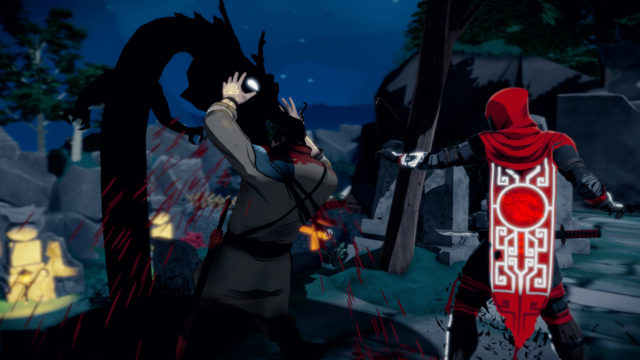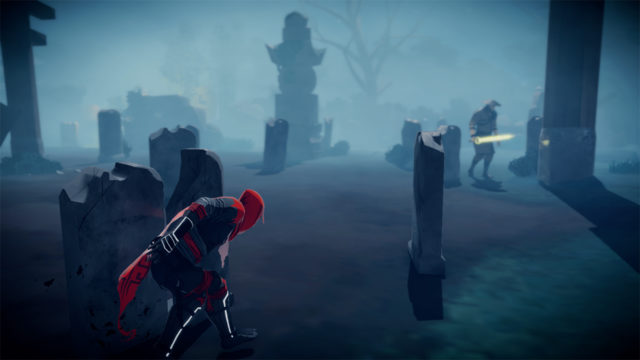Cool visuals and art direction; interesting story; old-school inspired gameplay intermixes new concepts
Limited use of sound design; occasionally clunky mechanics and animations; shadowy areas sometimes hard to distinguish from simply dark places
When we talk about retro-inspired indie games, our minds most often race to pixelated roguelikes and platformers that look like something for the SNES or NES. While Aragami: Shadow Edition definitely fits the bill of a retro-inspired indie game, it actually feels a lot more like a lost stealth-action game for GameCube. Considering the current state of the stealth genre, and indie games in general, this actually makes Lince Work’s title a surprisingly fresh and worthwhile experience.
Many aspects of Aragami bring to mind the GameCube, PS2, and Xbox generation, with the most immediately apparent being the visuals. The game doesn’t necessarily push the most polygons compared to other projects from exceptionally ambitious indie teams, or AAA developers, but it still manages to look good thanks to a strong sense of art direction. Like The Legend of Zelda: The Wind Waker, Aragami favors a cel-shaded style that makes the relatively simple geometry and flat textures actually look really good. Also, the Asian-inspired design is fairly unique and never feels like it’s just ripping off something like Okami. The fact that this is paired with a pretty good lighting system just help’s the game’s case. The only real visual hiccup is in terms of the animation, which sometimes feels a little stiff and slow, a problem that is never a hindrance to gameplay but does drag down the cutscenes somewhat.
And those cutscenes are actually important because there is a fairly strong emphasis placed on story throughout the game. You assume the role of an Aragami, a spirit summoned from beyond the shadows by Yamiko, a prisoner of the light-wielding Kaiho army who needs your help to free her. The rub is that you have to collect a series of magical talismans and sneak your way through the Kaiho army all within one night, as Aragami will fade the moment they face the sun’s light. As you progress, you see flashes of memories, both from Yamiko as well as yourself that help fill in the backstory. Naturally there are plenty of twists and turns, and while they don’t rewrite the playbook for video game storytelling, they are enough to keep your attention quite effectively. The game also includes a prequel chapter, Nightfall, however you’ll want to finish the main game first as it could spoil some pretty significant revelations.

Modern stealth games have generally embraced the open-world trend, giving you massive environments in which to sneak (and potentially murder) through. Aragami feels a little more old-fashioned in that it is much more linear, placing an emphasis on bite-sized sandboxes that still give you multiple options for tackling each objective and reaching each talisman. Many of your tools will be quite familiar for stealth fans, such as the ability to mark foes, make sounds to draw the enemy’s attention, and little bars that fill up as enemies notice you before fully recognizing your presence. Where Aragami differs is how it allows you to use shadows to rapidly and sneakily traverse the world. You can quickly warp between shadows and even temporarily summon pools of shadow to allow you to either sneak past guards or get into the optimal position to kill them. These abilities do need to recharge, but staying in the shadows allows you to constantly recharge your energy, while being in direct light actively drains it.
Though this assortment of powers is really what defines Aragami, it doesn’t stop the game from occasionally feeling clunky. As the game takes place entirely at night, fully shadowed areas can sometimes be difficult to fully distinguish from places that are just kind of dark. Also, getting your cursor to recognize these areas and thus allow you to warp can sometimes be hit or miss, a problem that only really becomes bothersome during brief moments where you must traverse platforms that quickly collapse under your weight. Furthermore, Aragami is quite old-school in how it handles things once you’ve been spotted. Escaping your rather stupid foes’ one-hit kill attacks is fairly simple, however it still generally results in you squatting in a bush for a couple of minutes as you wait for guards to give up and return to their regularly scheduled patrol routes. All things considered, this isn’t a big price to pay for making a mistake, but it does slow the flow of the game and can sometimes make the process of hunting down the scrolls needed to upgrade your abilities somewhat less appealing.

The game’s sound design also falls a bit short. The soundtrack is decent enough with plenty of appropriately Japanese-inspired tracks that fit the mood and setting nicely but none are particularly memorable or noteworthy. Also, while sound does play an important role in terms of gameplay, it doesn’t really feel like it has kept pace with newer entries in the genre. You can hear enemies walking by and they will notice your sounds, but it only really seems to have an impact if you are pretty much on top of them as you wander by or plunge a sword through their friend’s spine. So, while the sound is all there, it feels kind of strange that it is implemented in this way.
In embracing a more old-fashioned approach to stealth gameplay, Aragami: Shadow Edition makes itself standout but it also limits itself. At no point does it feel like you are playing something that’s trying to imitate the latest Far Cry or Metal Gear games and that can be rather refreshing, especially when combined with a worthwhile story and interesting art-style. However, it would have been nice if some of the worthwhile quality-of-life improvements and overall polish associated with more recent games could have found their way into the title, as well. Regardless, the end result is still a fun, generally good-looking game that doesn’t just feel like an unnecessary retread of past ideas, and as such it’s definitely worth at least a consideration for anyone interested in a stealthy experience.
Nintendojo was provided a copy of this game for review by a third party, though that does not affect our recommendation. For every review, Nintendojo uses a standard criteria.




 ShareThis
ShareThis





